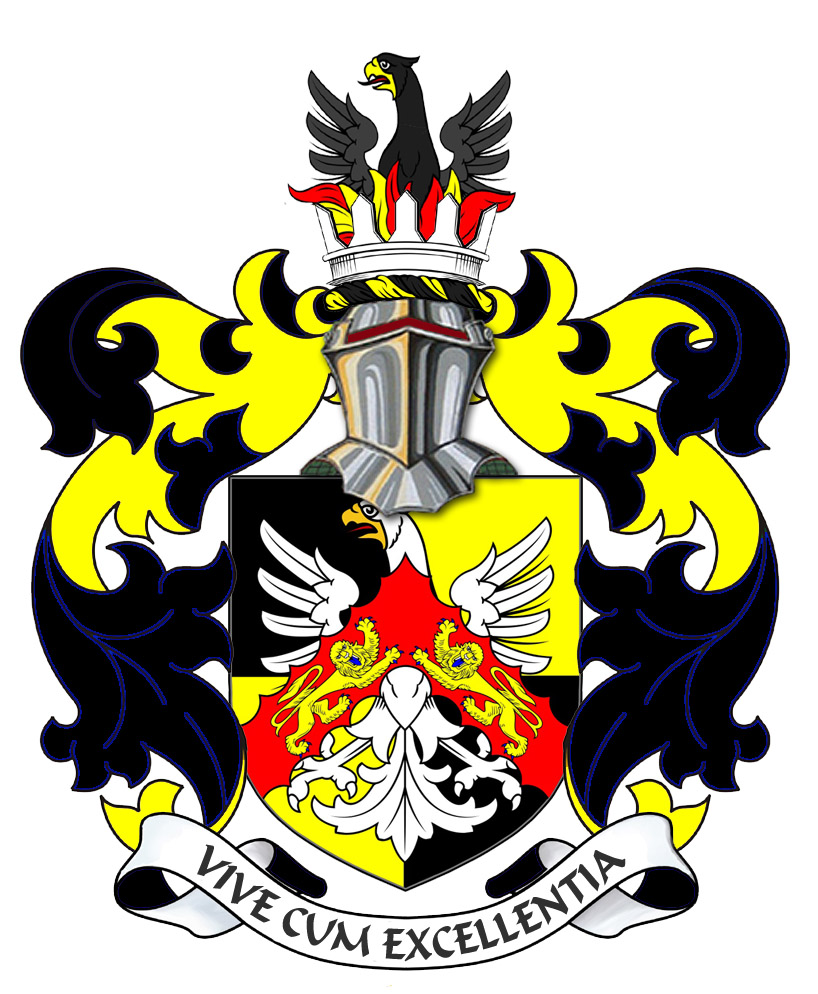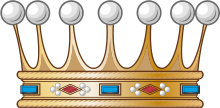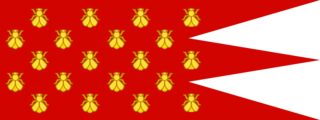


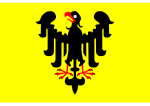
735 Year History of The Fief Blondel The Fief de Blondel has a history that goes back to the the first Viking Norman Duke, 918 AD who was Rollo the Viking. The Island of Guernsey has a history going back thousands of years, but the Guernsey Fiefs were not established until 1179 AD. Soon thereafter, the Separation of the Channel Islands from Normandy occured with the loss of Normandy to France by King John in 1204. The Noble Fiefs of Guernsey were reallocated to those loyal to the English Crown. Sir William De Chesney is named as the Seigneur of the Fief de Thomas Blondel in 1284 AD which is over 735 years ago For hundreds of years, this noble feudal Fief of Blondel has existed under the direct relationship with the Crown of England under the Tenant-in-Chief definition. The Fief of Thomas Blondel is located in the parishes of Torteval and St. Peter in the Wood and is an authentic Norman title direct from the Crown. The Seignuers (Free Lords) or (Danish Friherres) of Blondel are fiefs held direct from the crown and existed before formal Barononal titles were created. The Fief Blondel is part of the former larger Fief of Canelly, once held by William de Chesney (1284) and before him by the Le Canellys until the separation of Guernsey from French Normandy in 1204. 
FEUDAL DUES, CONGE AND TREIZIEME - Treizieme is the feudal due payable to the Crown 1/13th or 2% in Guernsey. It is payable to the Royal Court when the land is alienated. The Feudal Dues (Guernsey) Law of 1980 abolished Conge except in the case of alienating fiefs where the payment is still made in the Royal Courts to the Crown. It is payment of the Treizième to the Crown that results in the Conge. Counselor Mentz is one of the last people in the world to have Feudal Payment of Treizième accepted directly by the courts of the Crown for the Crown. Royal Court Document Fees paid by Counselor George Mentz 2018

DEED RECORDED On 27 February 2018 before the undersigned Messrs the Lieutenant Bailiff and Jurats of the Royal Court of this island of Guernsey appeared in person Mr Jason Brian Green, attorney duly appointed of Julio Emilio Marco Franco, esquire, of Voltor 17, Escalera 1, Bajo B, Palma, Mallorca, Islas Baleares 07011, according to his power of attorney which has been shown to us dated 13 February 2018, who by virtue of the power given to him has recognised and acknowledged having quit ceded transferred and totally transported from his said Appointor and from his heirs for ever and for an estate of inheritance to Mr. Mentz's Lawyer, Mr Paul Simon Nettleship, attorney duly appointed by George S Mentz, esquire, of Colorado Springs, Colorado 80906, United States of America According to his power of attorney which has been shown to us dated 29 December 2017, by virtue of the power given to him present and accepting for his said Appointor, George Mentz, viz. the Fief Thomas Blondel situated in the parishes of St Peter in the Wood and Torteval with all its appurtenances dependencies rights privileges and emoluments rents revenues dignities rights of court homages forfeitures champarts of corn services escheats and all other rights and seigneurial usages belonging to or dependent on the said fief without exception or reservation whatsoever other than the rights transferred to Her Majesty and Her Royal Successors by the Order of her Majesty in Council entitled "The Feudal Dues (Guernsey) Law, 1980". The said conveyance such and as much as it is as may belong to the said attorney-transferor as acquirer for George Mentz, Esq. of the said Fief Thomas Blondel from Barbara June Le Couteur widow of the late Mr Richard Evans and others by to a conveyance registered 14 September 2000. Made in consideration and for the price and sum of £XXXXXX Sterling which the said attorney-transferor recognises having presently received in good cash payment from the said attorney-transferee. And it is understood and conditional between the said parties that in the case there shall be due any homage relief fealty suit of court service rent chefrente or other right or due of whatsoever nature as may be owed to Her said Majesty or to any other seigneur whatsoever for and because of the said Fief Thomas Blondel the said attorney-transferee and his heirs or assigns in discharging the said attorney-transferor and his heirs shall not have recourse to nor guarantee against the said attorney-transferor or his heirs to whom the said attorney-transferee and his heirs. The said attorney-transferor has promised and obliges himself to furnish and guarantee the said cession sale and transport to hold them quit and exempt of all rents and dues of whatsoever nature save those particularly stipulated above on the obligation of all the estates personal and real present and future of the said attorney-transferor and of his heirs. And the said attorney-transferee is in enjoyment of the said fief and dependencies from today's date, and has produced a permit from Her Majesty's Receiver General to make the said sale quit of treizième [one-thirteenth of the price]. And the said parties declare in conformity with sections 5 (2) (a) and 5 (4) of the Order of Her Majesty in Council called "The Document Duty (Guernsey) Law, 2017" that the consideration expressed in this sale is the full one and it is made (in English) "at arm's length" on the grounds that the parties have contracted together of their own free will and independently one of the other.
1440 Deed of Blondel Fief - The Above 577 Year old Deed is Translated Below. To all who see or hear these present letters Denis Le Marchant judge in the
matter of
ABOVE IS A CERTIFIED
TRANSLATION - I, DARRYL MARK OGIER, BA PhD FRHistS of the island of Guernsey, certify having translated
from Middle French this copy of 1637 of an original deed dated 18 July 1440 to the best of my knowledge,
experience, and ability. This 4th day of July, 2018 The Fief de Thomas Blondel produced “ Livres de perchage ” in 1595, 1644, 1680, 1709, 1775, 1809, 1844, 1876, 1901, 1921 and 1968. The contents of the “ Livres de perchage ” reveal something of the history of the properties of the Territory and Fief boundaries.
Fief Canelly and Blondel 1205 - Historical Reference: After the Battle of Val Dunes (1047), Duke
William II created and granted several ecclesiastical fiefs. From 1144 to 1150 the whole island belonged to
Geoffrey d'Anjou. The wasteland of the Fief du Cotentin as part of the possessions of Geoffrey became under
his son Fief Le Roi. New sub-fiefs arose during the 11th and 12th centuries as Fief Aux Fay and Fief Burons.
The Fief Au Fay took place by paying a pair of silver spurs and Burons Fief by paying a pair of golden ears.
Both were combined as the Fief of Spurs with the obligation to pay a pair of spurs
vermeil.
THE FEODAL SYSTEM Without any political or judicial power for several decades, the feudal system of Guernsey has remained to this day. There are officially 75 fiefs, headed by a "lord" or "lady". The British Crown in the person of the Duke of Normandy, Queen Elizabeth II actually owns 29 of her strongholds, most of which belonged to abbeys or priory Lower Normandy, before the sixteenth century. This fact, in 2004, there were 24 private lords totaling 46 lordships inherited from this feudal system, except that two of these 46 seigneuries are in joint ownership between several owners. These fiefs belong to very old local lineages having given many officers, bailiffs, jurats and lawyers. These few families gather in their hands, as a result of endogamous marriages, many of the small rural fiefdoms, resulting from sharing throughout history, according to the precepts of Norman customary law, still in force. As in England and according to a centuries-old system, the fiefs can be sold by the lords to other individuals. Each lord is bound, according to custom, to make faith and homage to the duke or his representative. This tribute is sometimes staged during Queen's state visits to the Channel Islands. Unlike the Lord of Sercq, the Lords of Ceuresi have retained only the feudal rights, but have lost all their rights seigneuriaux since the nineteenth century and in the following. The lords played a social role until the first half of the 20th century. The feudal courts have also practically disappeared, with the exception of the courts of the fief Le Comte (family Lenfestey) or the fief of Blanchelande (the bailiff of Guernsey, ex officio, Saint-Martin). The seneschal of a fief, and his officers were usually chosen from the inhabitants of the fief, as required by feudal custom. In the example of the fief of Blanchelande, which formerly belonged to a priory of the former abbey of Blanchelande (in Neufmesnil, France, Manche), the court of fief is still composed today of the seneschal, four vavasseurs, and officers are the clerk and his clerk, the provost, a sergeant and a grenetier. In the fiefs, this court was held either in a special room or plaids room, or on a stone bench located on a main axis of the lordship. Some of these benches have been preserved.
John McCormack - 1980 - Snippet
view

Evolution of the Fief of Cotentin Translated from
French
Treizieme is the feudal due payable to the Crown 1/13th or 2% in Guernsey. It is
payable to the Royal Court when the land is alienated. The Feudal Dues (Guernsey) Law of 1980 abolished Conge
except in the case of alienating fiefs where the payment is still made in the royal courts to the
Crown.
"congé" means a document issued by or on behalf of Her Majesty's Receiver General
attesting receipt of the proper amount generally payable in accordance with the customary law in lieu of the
treizième, and of agreement by the Seigneur of a fief to a transfer of realty included therein;
"feudal dues" includes treizième, chef-rentes, escheat, varech (or wreck of the sea),
poulage, quarantaine and any other incidents of feudal tenure payable in money or money's worth,
"private fief" means a fief other than a fief belonging to Her Majesty.
Homage and fealty,, in European society, solemn acts of ritual by which a person became a vassal of a lord in feudal society. Homage was essentially the acknowledgment of the bond of tenure that existed between the two. It consisted of the vassal surrendering himself to the lord, symbolized by his kneeling and giving his joined hands to the lord, who clasped them in his own, thus accepting the surrender. Fealty was an oath of fidelity made by the vassal. In it he promised not to harm his lord or to do damage to his property. Although homage had to be rendered directly to the lord, fealty could be given to a bailiff or steward. The lord then performed a symbolic investiture of the new vassal, handing over to him some object representing his fief. The whole procedure was a recognition of both the assistance owed by the tenant to his lord and the protection owed by the lord to the tenant.
The 1980 Feudal Laws Act permanently extinguished the private character of the remaining seigneurial royalties
by transferring them to the Crown. In 2002, a complementary law provided for the abolition in 2003 of the
"thirteenth" right (transfer tax) for private lords, because of the exemption enjoyed by the farms held in
strongholds and the fiefs (seigneuries) . This tax is now returned to the Crown.
The lords and ladies of the most important fiefs Guernesiais traditionally sit in the Court of Chief pleas, with the lawyers practicing on the island and the constables elected parishes, during his solemn sessions "in body" (or full court) three times per year. To sit, the lords and ladies must have paid tribute to their fief to the Crown or his representative, the Lieutenant Governor of Guernsey. However, even if the presence of the lords and ladies is mandatory at these three sessions, they no longer participate in the debate but answer only to their name. This survival, however, indicates that the Guernsey seigneuries have retained their moral and legal personalities. Having become owners of several seigneuries (English: manors), a number of stately homes have been converted into a luxury hotel (hotel La Barbarie, for the fief of Blanchelande, or the manor of Longueville, Saint-Sauveur), or simply sold, which allows customary law. Some lords have maintained the area rich in rare botanicals, and open to visit, like the manor of Sausmarez (Sausmarez Manor). It still belongs to the family of Sausmarez, one of the oldest on the island with that of De Carteret. A similar situation exists in Jersey. TITLES OF GUERNESEY In 1020, Duke Richard II divides Guernsey diagonally from two halves, granting from south-east to Néel, Viscount of Cotentin and west to Anchetel, Vicomte du Bessin. The Clos du Valle was apparently wasteland. The two initial fiefs had some vicissitudes, but at the time of the conquest of England both returned to the families of the original 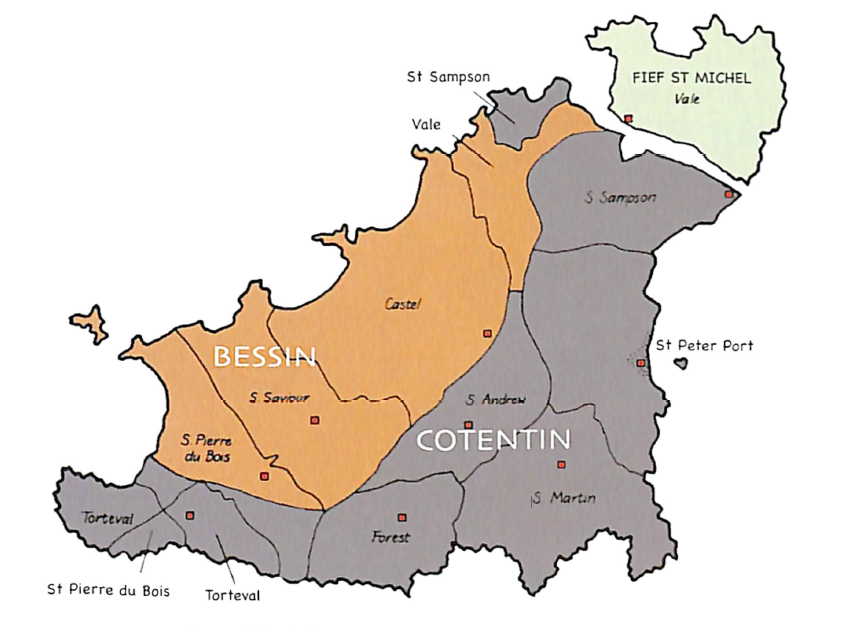
Below from" Fiefs of the Islands of Guernsey
Fief Blondel appears to be older than the Seigneurs of Monaco as the Grimaldi family settled in Monaco in 1297 and
Fief Blondel is also older than ancient Sheikhdom of Kuwait, Kingdom of Moscovy Russia 1362, Kingdom of Spain
1479, Kingdom of Bohemia, Kingdom of Belgium. Fief Blondel may also be older than the Ottomon Empire, Habsburg
Empire, and the Kingdom of Lithuania.
Description of the Lords of The European Fief of Blondel and Eperons - Est. 1179 Commissioner George Mentz is the Seigneur of the Fief Blondel & Eperons of Normandy which is an 800 year old territory on the Norman Islands. From the great Viking Rollo to the present day of the rule of King Charles, these islands have allowed feudal law and courts on the fiefs and island shores. The Fief Blondel and Eperons and its Seigneur are registered directly with the Royal Courts of the Crown and The Duke of Normandy and King Charles. Much like the Seigneurs of Monaco, the lords of French Andorra, Sovereign Gozo of Malta, the Sovereign Military Order of Malta (SMOM), The Papal Monarch of the Vatican City, and The Lord of Sark, The ancient Fiefs in the Channel islands are recognized by both nobility law and international law. Commissioner Dr. George Mentz was elevated as the 26th Free Lord & Seigneur of Fief of Blondel et L'Epersons) on the island of (Dgèrnésiais - Guernsey French) in Dec. 2017. Mentz also registered the fief direct with the courts using the feudal legal system of Conge and Tresieme which is the official way to transfer a fief from one noble leader or peer to another owner. The Fief of Thom. Blondel is One of the Last Great Private Fiefs in Europe to be privately owned where the lord owns the Beaches, Water, Foreshores and Seasteds including international Waters. In other local cultures, the free-lord Seigneur is known as a Frhr. Friherre in Sweden, a Frhr. Vrijheer in Dutch, and a Frhr. Friherre in Denmark. The Lords of Fief Blondel et Eperons appear to be older than the Seigneurs of Monaco as the Grimaldi family settled in Monaco in 1297 and Fief Blondel is also older than ancient Sheikhdom of Kuwait, Kingdom of Moscovy Russia 1362, Kingdom of Spain 1479, Kingdom of Bohemia, Kingdom of Belgium. Fief Blondel may also be older than the Ottoman Empire, Habsburg Empire, and the Kingdom of Lithuania. French: Le commissaire George Mentz est le seigneur du fief Blondel & Eperons de Normandie, un territoire vieux de 800 ans situé sur les îles normandes. Du grand Viking Rollo jusqu'à l'époque actuelle du règne du roi Charles, ces îles ont permis l'application du droit féodal et des tribunaux sur les fiefs et les côtes des îles. Le fief Blondel et Eperons ainsi que son seigneur sont enregistrés directement auprès des Cours Royales de la Couronne, du Duc de Normandie et du Roi Charles. Tout comme les seigneurs de Monaco, les seigneurs de la France, Andorre, le Souverain Gozo de Malte, l'Ordre Souverain Militaire de Malte (SMOM), le Monarque Papal de la Cité du Vatican et le Seigneur de Sark, les anciens fiefs des îles de la Manche sont reconnus à la fois par le droit de la noblesse et par le droit international. Le commissaire George Mentz a été élevé au rang de 26ème Seigneur Libre et Seigneur du fief de Blondel et L'Epersons) sur l'île de (Dgèrnésiais - français de Guernesey) en décembre 2017. Mentz a également enregistré le fief directement auprès des tribunaux en utilisant le système juridique féodal de Conge et Tresieme, qui est la manière officielle de transférer un fief d'un noble leader ou pair à un autre propriétaire. Le fief de Thom. Blondel est l'un des derniers grands fiefs privés en Europe à être la propriété privée où le seigneur possède les plages, l'eau, les rivages et les estrades maritimes, y compris les eaux internationales. Dans d'autres cultures locales, le seigneur libre Seigneur est connu sous le nom de Frhr. Friherre en Suède, un Frhr. Vrijheer en néerlandais, et un Frhr. Friherre au Danemark. Les seigneurs du fief Blondel et Eperons semblent être plus anciens que les seigneurs de Monaco car la famille Grimaldi s'est installée à Monaco en 1297 et le fief Blondel est également plus ancien que l'ancien émirat du Koweït, le royaume de Moscovy Russie 1362, le royaume d'Espagne 1479, le royaume de Bohème, le royaume de Belgique. Le fief Blondel pourrait également être plus ancien que l'Empire ottoman, l'Empire des Habsbourg et le royaume de Lituanie. German: Kommissar George Mentz ist der Seigneur des Fiefs Blondel & Eperons der Normandie, das ein 800 Jahre altes Territorium auf den Normanneninseln ist. Von dem großen Wikinger Rollo bis zur heutigen Zeit unter der Herrschaft von König Charles haben diese Inseln feudales Recht und Gerichte auf den Lehen und Inselküsten ermöglicht. Das Fief Blondel und Eperons sowie sein Seigneur sind direkt bei den Königlichen Gerichten der Krone, dem Herzog der Normandie und König Charles registriert. Ganz ähnlich wie die Seigneurs von Monaco, die Herren von Frankreich, Andorra, dem Souveränen Gozo von Malta, dem Souveränen Militärorden von Malta (SMOM), dem päpstlichen Monarchen des Vatikanstaats und dem Herrn von Sark werden die alten Lehen auf den Kanalinseln sowohl vom Adelsrecht als auch vom Völkerrecht anerkannt. Kommissar Dr. George Mentz wurde im Dezember 2017 zum 26. Freien Herrn & Seigneur des Fiefs von Blondel et L'Epersons) auf der Insel (Dgèrnésiais - Guernsey French) erhoben. Mentz registrierte das Lehen auch direkt bei den Gerichten unter Verwendung des feudalen Rechtssystems von Conge und Tresieme, das die offizielle Art und Weise ist, ein Lehen von einem adligen Führer oder Peer auf einen anderen Eigentümer zu übertragen. Das Fief von Thom. Blondel ist eines der letzten großen privaten Lehens in Europa, das privat besessen ist, wo der Herr die Strände, das Wasser, die Küsten und die Meeresstädte einschließlich der internationalen Gewässer besitzt. In anderen lokalen Kulturen ist der freie Herr Seigneur als Frhr. Friherre in Schweden, ein Frhr. Vrijheer im Niederländischen und ein Frhr. Friherre in Dänemark bekannt. Die Herren des Fiefs Blondel et Eperons scheinen älter zu sein als die Seigneurs von Monaco, da sich die Familie Grimaldi 1297 in Monaco niederließ und das Fief Blondel auch älter ist als das alte Scheichtum Kuwait, das Königreich Moscovy Russland 1362, das Königreich Spanien 1479, das Königreich Böhmen, das Königreich Belgien. Das Fief Blondel könnte auch älter sein als das Osmanische Reich, das Habsburgerreich und das Königreich Litauen. Italian: Il commissario George Mentz è il signore del Feudo Blondel & Eperons della Normandia, un territorio di 800 anni situato nelle isole normanne. Dal grande vichingo Rollo ai giorni nostri sotto il regno di Re Carlo, queste isole hanno permesso l'applicazione della legge feudale e dei tribunali sui feudi e sulle coste delle isole. Il Feudo Blondel ed Eperons e il suo signore sono registrati direttamente presso i Tribunali Reali della Corona, il Duca di Normandia e Re Carlo. Molto simili ai signori di Monaco, i signori della Francia, Andorra, il Sovrano Gozo di Malta, il Sovrano Militare Ordine di Malta (SMOM), il Monarca Papale della Città del Vaticano e il Signore di Sark, gli antichi Feudi delle isole del Canale sono riconosciuti sia dalla legge nobiliare che dal diritto internazionale. Il commissario Dr. George Mentz è stato elevato al rango di 26° Signore Libero & Signore del Feudo di Blondel et L'Epersons) nell'isola di (Dgèrnésiais - Guernsey French) nel dicembre 2017. Mentz ha anche registrato il feudo direttamente presso i tribunali utilizzando il sistema giuridico feudale di Conge e Tresieme, che è il modo ufficiale per trasferire un feudo da un nobile leader o pari a un altro proprietario. Il Feudo di Thom. Blondel è uno degli ultimi grandi feudi privati in Europa a essere di proprietà privata, dove il signore possiede le spiagge, l'acqua, le rive e le città marittime, comprese le acque internazionali. In altre culture locali, il Signore libero Seigneur è conosciuto come Frhr. Friherre in Svezia, un Frhr. Vrijheer in olandese e un Frhr. Friherre in Danimarca. I Signori del Feudo Blondel et Eperons sembrano essere più antichi dei Signori di Monaco, poiché la famiglia Grimaldi si stabilì a Monaco nel 1297 e il Feudo Blondel è anche più antico dell'antico sceicco del Kuwait, del Regno di Moscovia Russia 1362, del Regno di Spagna 1479, del Regno di Boemia, del Regno del Belgio. Il Feudo Blondel potrebbe anche essere più antico dell'Impero Ottomano, dell'Impero degli Asburgo e del Regno di Lituania. Spanish: El comisionado George Mentz es el Señor del Feudo Blondel & Eperons de Normandía, un territorio de 800 años en las Islas Normandas. Desde el gran vikingo Rollo hasta la actualidad bajo el reinado del Rey Carlos, estas islas han permitido la aplicación de la ley feudal y los tribunales en los feudos y las costas de las islas. El Feudo Blondel y Eperons y su Señor están registrados directamente en los Tribunales Reales de la Corona, el Duque de Normandía y el Rey Carlos. Al igual que los Señores de Mónaco, los señores de Francia, Andorra, el Soberano Gozo de Malta, la Orden Militar Soberana de Malta (SMOM), el Monarca Papal de la Ciudad del Vaticano y el Señor de Sark, los antiguos Feudos de las Islas del Canal son reconocidos tanto por la ley nobiliaria como por el derecho internacional. El comisionado Dr. George Mentz fue elevado al rango de 26º Señor Libre y Señor del Feudo de Blondel et L'Epersons) en la isla de (Dgèrnésiais - Guernsey French) en diciembre de 2017. Mentz también registró el feudo directamente en los tribunales utilizando el sistema legal feudal de Conge y Tresieme, que es la forma oficial de transferir un feudo de un líder noble o par a otro propietario. El Feudo de Thom. Blondel es uno de los últimos grandes feudos privados en Europa en ser de propiedad privada, donde el señor posee las playas, el agua, las costas y las ciudades marítimas, incluidas las aguas internacionales. En otras culturas locales, el Señor libre Señor se conoce como Frhr. Friherre en Suecia, un Frhr. Vrijheer en holandés y un Frhr. Friherre en Dinamarca. Los Señores del Feudo Blondel et Eperons parecen ser más antiguos que los Señores de Mónaco, ya que la familia Grimaldi se estableció en Mónaco en 1297 y el Feudo Blondel también es más antiguo que el antiguo jeque del Kuwait, el Reino de Moscovia Rusia 1362, el Reino de España 1479, el Reino de Bohemia, el Reino de Bélgica. El Feudo Blondel también podría ser más antiguo que el Imperio Otomano, el Imperio de los Habsburgo y el Reino de Lituania. |
Kingdom of West Francia Lord Paramount Feudal Barons The Seigneur Charter of Liberties Viking Kingdom Extended Continental Shelf Fief Worship Fiefs of the Islands Fief de l'Eperon Order of the Iron Crown Blondel Privy Seal Fief DuQuemin Bouvée Phlipot Pain Bouvée Torquetil Bouvée Bourgeon Channel Island History Feif Court Styles and Dignities Fief Blondel Islands Court of Chief Pleas Seigneurs and Dames Travel Research Order of the Genet Order of the Genet Order of the Star Est. 1022 Order of the White Falcon Territorial Waters Order of Celestines Knights of theThistle of Bourbon A Funny Think Happened On the Way to the Fief Arms Motto Flower Chancellor Hereditements Guernsey Bailiwick of Guernsey - Crown Dependency Papal Bull Norse Normandy Fief Rights Blondel and King Richard Press Carnival Store Portelet Beach Roquaine Bay Neustrasia Columbier Dovecote Fief Blondel Merchandise Fief Blondel Beaches Islands Foreshore Events Fiefs For Sale Sold Fief Coin Viscounts de Contentin Fief Blondel Map Feudal Guernsey Titles The Feudal System Flag & Arms Fief Videos Guernsey Castle Advowson Site Map Disclaimer Livres de perchage Lord Baron Longford Dictionary
Feudal Lord of the Fief Blondel of the Nordic Channel Islands Guernsey Est.
1179
Feudalherr - Fief Blondel von der Nordischen Insel Guernsey Est. 1179
New York Gazette - Magazine of Wall Street -
George Mentz -
George Mentz - Aspen Commission
Counselor George Mentz Esq. - Seigneur Feif BlondelBaron Annaly Baron Moyashel Grants to Delvin About Longford Styles and Dignities The Seigneur Court Barons Fiefs of the Islands Longford Map The Island Lords Market & Fair Fief Worship Channel Island History Fief Blondel Lord Baron Longford Fief Rights Fief Blondel Merchandise Events Blondel and King Richard Fief Coin Feudal Guernsey Titles The Feudal System Flag & Arms Castle Site Map Disclaimer Blondel Myth DictionaryKingdom West Francia Kingdom of the FranksMentz Scholarship Program 101 Million Donation - Order of the Genet Knighthood |
